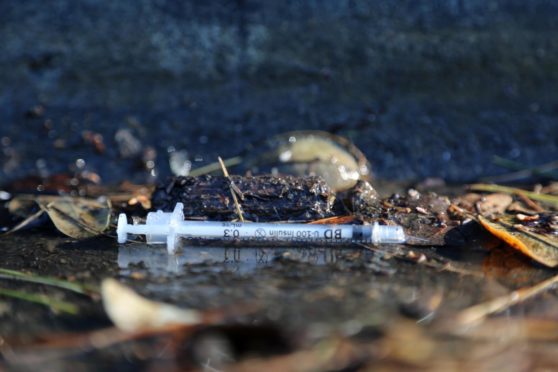Drug deaths in Scotland have reached a record high, with more people dying due to substance abuse in 2020.
A total of 1,339 deaths last year were attributed to drugs, up from 1,264, new statistics have revealed.
This is an increase of 5.9% on figures from 2019.
This was down slightly on the increase between 2018 and 2019 of 6%.
The annual statistics from the National Records of Scotland (NRS) show the rate of deaths in Scotland is some 3½ times that of the UK as a whole.
It is also higher than any other European country.
As figures rise again across the country, the number of drug-related deaths per million people in Dundee fell compared to 2020.
Glasgow was first with 45.78 per 100,000, followed by Inverclyde with 42.82.
Figures show that Aberdeenshire was the second lowest area with 9.3 per 100,000.
Moray was relatively low with 12.4 per 100,000 and the Highlands recorded 12.8.
Meanwhile, Aberdeen City had 22.7 which is an increase of 12.
The biggest killers
Most deaths from drugs were linked to the use of more than one drug, or so-called “polydrug use.”
In most deaths in Scotland linked to drugs, opiates such as heroin and methadone were involved, with users adding other substances like benzodiazepines such as “street valium”.
In Grampian and the Highlands most deaths were linked to opiates. Aberdeen City recorded 50 deaths linked to opiates such as heroin and morphine, however, there were also 42 resulting from cocaine use.
Age of those dying
The aging population of drug users in Scotland has long been recognised, with figures showing the majority of those dying were aged between 35 and 54.
Men were 2.7 times as likely to have a drug-related death than women, after adjusting for age.
After adjusting for age, people in the most deprived parts of the country were 18 times as likely to die from a drug-related death as those in the least deprived.
Government respond to Scotland’s drugs statistics
Earlier this year, First Minister Nicola Sturgeon met a furious backlash when she admitted the SNP Government had fallen short of tackling a national drug-death shame.
She scrambled to undo the damage shortly before the Holyrood election, saying the phrase – “we took our eye off the ball” – did not mean her administration “didn’t bother” to address the health emergency.
Scottish Conservative leader, Douglas Ross, described the latest statistics as “horrifying and heartbreaking”.
He said: “Behind every number is a lost loved one and a broken family.
“These shocking figures alone cannot capture the agony, pain and devastation that the drugs crisis is causing in communities across Scotland.”
Mr Ross has called for a national effort to make drastic changes to the system.
He said: “The Scottish Conservatives are bringing forward a Right to Recovery Bill to guarantee in law that everyone who needs treatment can get it.
“The Scottish Parliament passed Covid laws in three days. We can introduce a Right to Recovery law swiftly if we adopt a similar sense of urgency.
“Overnight, we won’t end this crisis. But we can start on the right path today and take the necessary action now, if the government throws their weight behind this proposal.”
Today, drugs policy minister Angela Constance has described the increase in drug-related deaths as “heart-breaking”, and reiterated the Scottish Government’s determination to continue its work to address the crisis.
Ms Constance said: “Once again, the statistics on drug-related deaths are heart-breaking. I want to offer my sincere condolences to everyone who has lost a loved one through drug use.
“We need to gather as much information as we can about drug use in Scotland and to that end, data on suspected drug deaths will be published quarterly from this September. This will ensure we can react more quickly and effectively to this crisis and identify any emerging trends.
“We are working hard to get more people into the treatment that works for them as quickly as possible.
“Without treatment, there is little hope of recovery so we are funding as many community and third sector initiatives as we can so that individuals have the widest possible choice and can opt for the support which suits them and their family.
‘Avoidable tragedy’
“Of the £250 million announced over the next five years, £100 million will go on improving the provision of residential rehabilitation and I will update Parliament on progress in this area after the summer recess.
“As I have said before, I am determined that every penny of this additional funding will make a difference to all those affected by drug use in Scotland.”
Drug Deaths Taskforce chairwoman, Professor Catriona Matheson, said: “Every drug-related death in Scotland is an avoidable tragedy, and these figures serve to remind us of the importance and urgency of our mission to identify the areas of action that can make a sustainable impact against the challenge.
Both the causes of, and the solutions to, the challenge we all face are complex
“We believe the approach of putting evidence into action has saved lives, and we will analyse the detail behind the headlines and look to build upon those areas showing progress and to address those areas requiring more attention.
“Both the causes of, and the solutions to, the challenge we all face are complex, at its heart are real people at real risk, and we continue to be determined to make difference for them.”
Alan Ferrier, head of demographic statistics at NRS, said: “Sadly, last year saw the highest number of drug-related deaths in Scotland since reporting began 25 years ago, and 59 more deaths than were registered in 2019.
“At the beginning of the century, the rate of drug-related deaths in Scotland’s most deprived areas was 10 times that of our least deprived areas. By 2020 this gap had increased to 18 times as high.”
